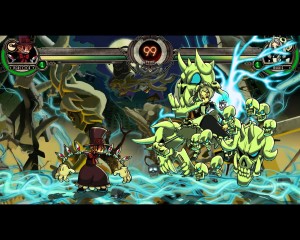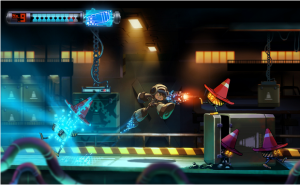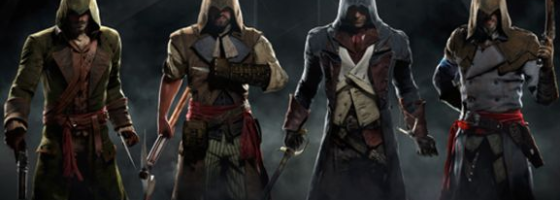Following E3’s presentation this week, it was reported how few female presenters there were among the various conferences. And to make things worse, Ubisoft talked about how they are removing female avatars from the next Assassin’s Creed game due to them saying that it would require too much additional work. This reignited the debate about the lack of women in the Game Industry and people wanting to see more female characters.
This also raised the issue of people just wanting gender options in every video game no matter what the game is and this is where I have to disagree as the type of game does impact who the main character is.
Set vs. Customize Plots:
When it comes to writing a plot for a video game, we can break things down into two very broad categories.
A Set Plot means that the main character is central to the story: Their personality, gender, physical build, etc and changing them would change the story. Some examples would be Bioshock Infinite, Metal Gear Solid, Tomb Raider and South Park the Stick of Truth.
In these titles, the main character’s traits and personality are a major part of the story. And while there can be some personalization on the player’s part, it’s not the player who is a part of the story but the main character.

Games with set narratives have a main character whose personality and characteristics are central to the story.
A Customize Plot is where the story is more focused on the environment or situation around them and the main character is essentially a cipher for the player.
Some examples would be MMOs, Diablo 3, Mass Effect, non MMO multiplayer games, XCOM and Dark Souls. While the player can choose a gender or class, their choice does not impact the plot whatsoever and is more about the player customizing their experience.
In other words a customize plot is gender neutral for the most part. There might be some scenes or different dialogue based on the gender/class/race of the player, but the overall plot does not change. With Mass Effect, it is a special situation as the main character of Sheppard does impact the plot and is central to the game. However the details of who Sheppard is which is determined by the player is a variable.
The Gender Development Gap:
With the types of plots explained, let’s go back to Ubisoft’s statement. Their rationale is that the cost to develop female characters would be too expensive for the development of Assassin’s Creed Unity.
And on that fact they do have a point in terms of cost relatively speaking. Anything that you add or develop for a game will add to the development cost. This is why a lot of indie developers don’t develop multiple characters as they don’t have the budget for it.

Skullgirls is the perfect example of why it’s not always so easy to add new characters to a game and the cost that goes into it.
Designing and animating different main characters can be costly. And if you’re developing a game with a set plot or one where the narrative focuses heavily on the main character, a complete redesign could break the budget.
Another major factor is if you’re developing a game around a unique art and animation style like Skull Girls; they had to raise an additional $150,000 just for one new character.
With The Walking Dead season one; the narrative’s foundation was based on the characters of Lee and Clementine. To design the game to be more gender neutral by allowing players to switch their respective genders would have skyrocketed their development budget, not to mention rerecording all the basic dialogue and adding new dialogue in.
This is where I take the stance of not every game should be gender inclusive. If you’re developing a set plot that is around a male or female character, then focus on that one character. Otherwise you’re just diluting the narrative. A game like Metal Gear Solid or Tomb Raider would be a different game narrative wise if players could just swap Snake or Lara with a different gender character to run through the same game story.
With that said however, if the character doesn’t have any bearing on the plot personality wise, I see no reason to not factor different genders into the budget. All the more so if you are making an online game or multiplayer mode where there isn’t really a character driven story per say. From what people have been saying, it sounds more like Ubisoft didn’t think at all about including playable female characters and are now in damage control after people are arguing for it.
And to make things worse for Ubisoft, there have been people who work for Ubisoft refuting their claim that having female characters would break their budget.
Trying to Defining Character Traits and Genders:
Even though Mario and Link are “set” characters in the sense of their recognition, I wouldn’t mind if Nintendo made it so that you could play as Peach or Zelda and do all the same gameplay with them. Same goes for the Mighty No. 9 which gamers raised complaints about having a female playable character. The character’s abilities are central to the plot, not their personality and to think that having a male or female lead would ruin the game is silly.

Platformers or games with basic plots don’t have narratives defined by gender and it shouldn’t be that hard to write for either a male or female protagonist.
That last sentence is important for anyone writing a narrative. Special abilities or powers that are gender neutral are not grounds for dictating a gender.
Nor is sexualization a good reason to have a character be female just to have them wear sexy clothes.
For example Samus from Metroid evolved into a strong female character even though her predominant characteristics are more masculine in nature and her special abilities are not gender defined.
I think most people will agree that falling back on “straight white man” as the protagonist du jour is becoming tiresome. If you’re making a modern or futuristic game, limited character designs to only a few skin tones and nationalities does more harm than good.
Now of course the one area that has its own can of worms would be period piece games where the roles of the different genders can conform to societal rules. However if you are dealing with an unrealistic situation to begin with, then you can’t say that a woman would never be a master assassin fighting templars or whatever the Assassin’s Creed mythos is about now. Or for example, in Assassin’s Creed 3 you played as a Native American.
When it comes to set plots, I say that the writer should focus on either making a strong male lead or a strong female lead, not trying to make a story that can be adapted to either. Now that’s not me calling for everyone to only make male driven games as I want to see more diverse character other than white, stocky, grizzled wall of meat men.
Part of the problem I feel is that the AAA industry is so focused on sequels to games so they don’t want to create new characters. And the series that are getting these sequels all feature the same white male protagonist. I really hope that this generation we start seeing new series that actually try to do something different with character design.
For the designers reading this it’s important to take note that consumers will point out games built around customization that don’t have different genders. And that not only has to do with single player games but multiplayer ones as well. I think it’s great that so many people questioned why Nintendo didn’t include same sex marriage as an option in Tomodachi Life as it means that people are questioning these status quos of the Game Industry.
If your game is sending the message that you can create anyone you want… as long as they are male (or worse: only straight white males,) don’t be surprised if people call you out on that.


Pingback: Link des Tages: »Gender’s Role and the Debate on Narrative« | Spiele-Entwickler Community()